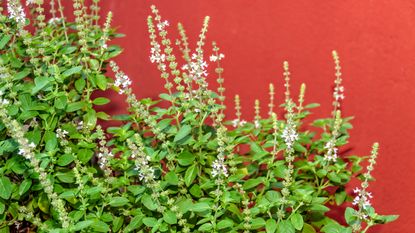Basil Flowers: To Pinch Or Not To Pinch?
Basil flowers are delightful in salads and for tea, but plucking them also benefits the growth and aroma of the green leaves that are so tasty in cooking.


When a basil flowers, most gardeners quickly remove the blossoms to increase the plant’s leaf development and prevent them from turning bitter. After all, it’s the pungent leaves that season our delicious dishes, not the flowers on basil. Basil grows in the warm season, usually from seed, producing a small bushy plant that produces attractive flowers over time. But do we have to pinch off the pretty blooms?
Should I Let My Basil Flower?
When a basil is flowering, it becomes a magnet for numerous beneficial pollinators. The sweet scent and bright blooms are attractive to bees and other insects. Thus, a basil plant flowering can be a good thing for your other plants and can help enhance fruit production.
However, the flowering also signals reproduction, which isn’t required in a plant grown for its foliage unless you want to save seed. Removing the flowers when they are first spotted will help keep the spicy flavor of the leaves sweet. Letting the flowers continue can lead to less flavor in the foliage. So, leaving flowers on basil is strictly an individual choice, but removing them allows the plant to direct its energy to the formation of leaves, rather than blooms.
How & When to Pinch Basil
Basil responds favorably to consistent pinching. Removing plant material from the tips stimulates the production of cytokinin, a hormone that increases bushiness.
Once young basil plants are in the ground, they should be pinched at the top cluster of leaves. This will encourage the formation of more leaves and produce a more compact plant instead of one that is leggy and long-stemmed with few leaves.
By the 6th week, it is time to watch for flowers forming. Go ahead and pinch those off to promote leaf development. The plant will continue to produce flower buds during the growing season; monitor them and remove the blooms before they mature.
Pinching by using the thumb and forefinger in a pincer motion is the most common method. Pruners or scissors may also be used to remove plant material. Consistent harvesting of the leaves will minimize the formation of flowers.
Gardening tips, videos, info and more delivered right to your inbox!
Sign up for the Gardening Know How newsletter today and receive a free download of our most popular eBook "How to Grow Delicious Tomatoes."
What to Do With Basil Flowers
Basil flowers are edible. They have a milder flavor than the leaves and can sometimes be a bit bitter. They are attractive and tasty when sprinkled on a salad. The flowers are also nice garnishes for anything that generally goes with basil, such as cheese or pasta.
Basil flowers may also be used to make an aromatic oil or vinegar. Wash the flowers and let them air dry. Then immerse them in a mild vinegar or olive oil. Let the flowers steep in the vinegar for a week, and 1 month for the oil. Strain out the solids and store the vinegar or oil in a cool, dark location.
Frequently Asked Questions
Is Basil Still Good After It Flowers?
Many gardeners and foodies feel the leaves become bitter after the plant flowers. Actually, it is the older leaves that develop a slightly bitter flavor, with or without the flowers. The young leaves are sweeter. Leaving the flowers on the plant will not severely affect the taste, but will diminish the plant’s leaf production and cause it to die back much more quickly. Pinching off the blooms will encourage more tasty, young leaves.
Can You Eat Basil Flowers?
Basil flowers can be eaten in a variety of ways but they can also be drunk. Basil tea has a delightful aroma, and subtle flavor. Simply put the flowers in a cup and pour boiling water over them. Strain out the flowers and enjoy a heavenly-scented, hot beverage.

Bonnie Grant is a professional landscaper with a Certification in Urban Gardening. She has been gardening and writing for 15 years. A former professional chef, she has a passion for edible landscaping.
-
 Types Of Peonies Every Gardener Should Know
Types Of Peonies Every Gardener Should KnowKnowing the different types of peonies helps when you want your garden to include these fabulous plants. Showy and always impressive, peonies are an elegant addition.
By Bonnie L. Grant
-
 7 Sustainable Trends All Gardeners Should Take From The UK's Chelsea Flower Show
7 Sustainable Trends All Gardeners Should Take From The UK's Chelsea Flower ShowThe RHS Chelsea Flower Show 2024 is championing sustainability, with a focus on water conservation and creating resilient landscaping schemes in the face of climate change. Discover the key ideas to take away for your own garden.
By Melanie Griffiths